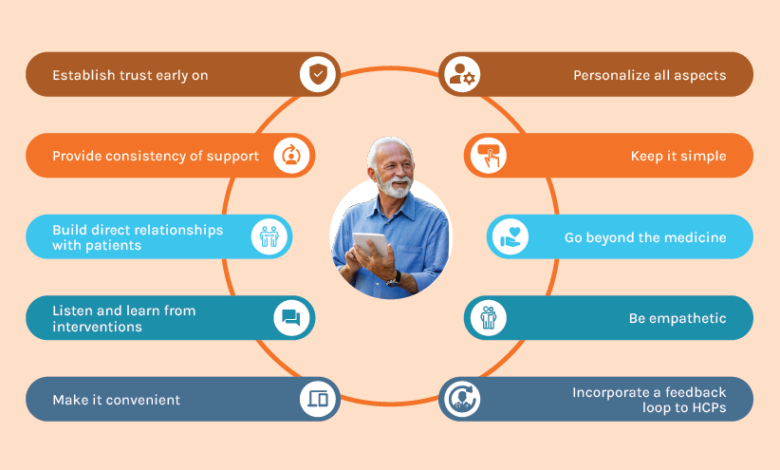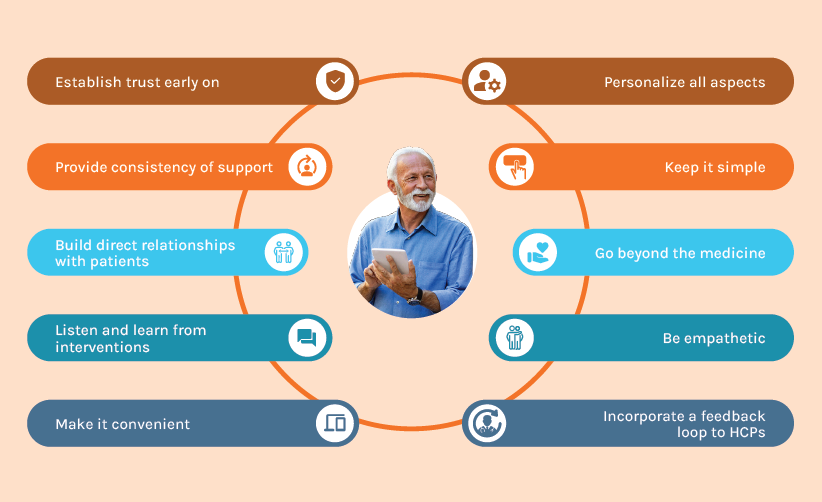Building Trusted Relationships in the Digital Healthcare Era: 10 Pillars for Exceptional Patient Engagement

Sponsored Content Submission to Pharma Leaders
1/16/24
As the biopharma industry continues to shift to more patient-centric models of engagement, it is moving away from the traditional focus of simply providing medication to a more innovative model that caters to all of the patients’ therapeutic needs.
This approach to supporting patients is not limited to medical treatment for illnesses but also extends to wellness, preventive care, and the overall patient experience. To achieve this model, many pharma companies are establishing fully integrated patient-centered ecosystems. These ecosystems include all the necessary services, data, and other technology products required to facilitate a patient engagement program “beyond the pill.” The goal is to contribute to disease prevention, risk awareness, post-treatment support, and overall patient wellness. The programs create an integrated environment where human engagement, technology, and gathered data work together symbiotically to establish a new standard for patient-centric engagement.
Significant innovation has been directed towards realizing this patient engagement model, which comprises three key elements:
- High-Tech, Human Care: This element harnesses technology to enable scalable and personalized human engagement. Advanced tools and systems enhance the quality and effectiveness of interactions between healthcare professionals and patients.
- Evidence Generation Loop: The evidence generation loop focuses on capturing real-world data related to health outcomes. This data serves as the foundation for establishing an evidence and insights engine. This enables the development of innovative commercial arrangements based on reliable evidence.
- Service Management Loop: The service management loop involves the capture of patient experience, operation, and other relevant data. This data drives continuous improvement in the patient engagement program. Insights gained from the data refine and enhance the program over time.
The New Pillars of Patient Engagement
Patient engagement solution providers recognize the crucial factors that lead to success in a patient-centric world. These key factors strengthen the bond between patients and healthcare stakeholders and facilitate a more personalized, convenient, and supportive healthcare journey.
There are ten foundational elements for exceptional patient engagement programs that drive superior efficacy and efficiency. To achieve transformational world-class patient engagement that places patients at the core of their care, the program design, implementation, and management should incorporate and adhere to these ten pillars:

- Establish Trust Early On. Introduce patients to a go-to resource for questions and help at time of consent.
- Provide Consistency of Support. Patients are paired with a primary point of contact throughout their time on therapy, not needing to transition from stakeholder to stakeholder in the process.
- Build Direct Relationships with Patients. Systematically and compliantly share patient data with pharma clients to allow for direct outreach and connectivity.
- Listen and Learn from Interventions. Capture the voice of the market from patient engagement interventions and use this actionable data to influence program optimizations and overall brand strategy.
- Make it Convenient. Deliver a patient engagement program that meets patients when and where they need and want support, and seamlessly integrate it into their day-to-day lives.
- Personalize All Aspects. Tailor all facets of the patient engagement program, including the types of interventions, level of support and areas of focus based on each individual patient.
- Keep It Simple. Design and build the patient engagement program to be intuitive, with a focus on reducing complexity versus adding complexity to an already overwhelming process.
- Go Beyond the Medicine. Integrate patient engagement elements focused on patient needs beyond the typical financial, logistical, and clinical areas of support.
- Be Empathetic. Use technology to augment and enhance the human element of patient engagement, not replace it.
- Incorporate a Feedback Loop to HCPs. Share back to the HCP/office key information from the patient engagement program in an easy-to-consume manner to aid in a more progressive patient-physician dialogue.
Digital healthcare is a rapidly evolving landscape. A key tenet of this new landscape is establishing trusted relationships with patients. Forging these connections is the cornerstone for unlocking the full potential of technology and ensuring patient well-being.
To download a copy of the complete whitepaper on this topic, please visit VMS BioMarketing.





